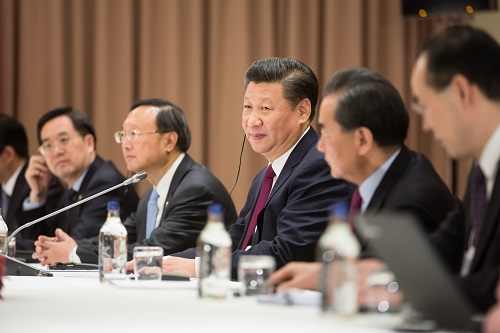Issue Briefs

China’s Ambitious “One Belt One Road” Project Will Promote Growth
By Martin Sieff
May 22, 2017
Four years after its formal launch in 2013, President Xi Jinping’s “One Belt, One Road” (OBOR) initiative continues to quietly generate momentum as one of the most important geostrategic developments of the new millennium.
Expressions of skepticism about the OBOR project remain widespread in the Western media. The latest fashion is to deride Beijing for economic and strategic over-extension, launching a project of such magnitude and ambition aimed at extending its infrastructure building across Asia, all the way to the Middle East and even Africa. Beijing will never be able justify the massive outlay in investment, the critics say.
There are however two answers to this objection. Both of them, ironically, are grounded in the successful transportation infrastructure projects of U.S. history over the past 160 years.
Lessons from U.S. history
Until recently, the truly colossal construction project in human history was not the Great Wall of China or the three greatest pyramids of Egypt: It was the federal Inter-State Highway System of the United States pushed through by President Dwight D. Eisenhower in the Federal Aid Highway Act of 1956.
More than 60 years on, the scale of this project still boggles the mind: It took 35 years to complete the original program, even though some sections were later scrapped.
The network has since been extended and Wikipedia notes that by 2013 it had a total length of 47,856 miles (77,017 km). Fifty seven years after the project was begun the roads built for it still carried 25 percent of all vehicle miles driven in the United States. Wikipedia also noted that in 2006 the cost of construction was estimated at about $425 billion in current dollars, a figure that was raised to $511 billion in 2015 dollars.
A great success
There is no dispute that the Inter-State Highway System has been a fantastic success. Clearly this national ground transportation network continues to add in limitless ways to the growth and prosperity of the U.S. domestic economy. Equally clearly, the scale of this continuing contribution more than 60 years on was never envisaged when the original program was approved.
Like the OBOR system, the Interstate Highway System bound together a vast continent with a depth and scale of ground transportation networks never before envisaged.
Large resources were mobilized
Like the OBOR system, it was made possible by immense reservoirs of wealth and disposable income piled up by a government and U.S. national economy that had nurtured its prime industrial and manufacturing base.
As the OBOR system is also anticipated to do, the Interstate Highway program provided a gigantic Keynesian Multiplier Effect for the great domestic continental economy it primarily served.
A catalyst for economic growth
Crucially important too is the continuing fact that the Interstate Highway System did not impoverish some areas of the continental United States while enriching others. It generated rapid and widespread economic growth dramatically raising standards of living wherever it was constructed.
The Interstate Highway System demonstrated the simplistic and ruinous falsehoods of the ideological extremes of economic left and right.
It was built through a colossal partnership between the private sector and the national government. It gave the lie to Soviet-style communism or any kind of socialist centralized micro-management of economic planning.
It also gave the lie to the simplistic, reductionist 18th century fantasy that national governments must stay out of the economic sphere entirely, because if they do participate in it, they are bound to get everything wrong.
The U.S. Government consistently promoted infrastructure building
In fact, U.S. economic history from the earliest days of the Republic gives the lie to this kind of simplistic nonsense so beloved by the Cato Institute and the infantile devotees of Ayn Rand.
Abraham Lincoln himself promoted federal government support for the great Union Pacific Railroad across the North American continent that was built while Washington was almost completely focused on conducting the Civil War.
Later on, U.S. global superiority in the aerospace industry came about because of the vast government –private industry partnerships forged at breakneck pace immediately before and through World War II.
Likewise, the Internet was developed initially by government agencies (ARPANET) later on working with the private sector. Many more examples in which Washington played a lead role in promoting major infrastructure and/or industrial partnerships can be named.
Chinese Government in the lead
China appears assured to develop its OBOR project with the same pragmatism and adaptability that Paramount Leader Deng Xiaoping expressed with typical clarity and pithiness almost four decades ago. Deng famously said that it did not matter what kind of a cat one had as long as it caught mice.
Nor need the argument that China has bitten off more than it can chew by launching the OBOR program be taken seriously.
Over the past 40 years, China has developed the greatest concentration of industrial and manufacturing capability on the planet. Beijing’s success in raising the overall standard of living of Chinese people, while also boosting that of surrounding economies, have ranked among the greatest achievements of the human race.
Now, China’s investments and still rapidly growing market for energy, food staples an raw materials has become the greatest economic engine powering the major economies, reaching out to Africa as well.
OBOR’s value
Why is OBOR so important for China? Is it a sign that China intends to further promote globalization and regional cooperation? How should China try to seek more chances of cooperation with other countries’ strategies?
China’s OBOR initiative is of the greatest importance in promoting peace and stability in two crucial regions of the world – Central Asia and Eastern Europe.
Central Asia’s most visionary leaders, President Nursultan Nazarbayev of Kazakhstan and the current leaders of Kyrgyzstan and Turkmenistan have grasped the enormous value to their peoples of transforming their region of the world, for so long neglected as peripheral, into a central artery of world communication and commerce.
Central Asia as the heartland of the world
The OBOR program offers the prospect of fulfilling through peaceful means rising living standards and improved international cooperation and understanding, with the goal of making the heartland of the “World Island” – the combined continents of Asia, Europe and Africa – the communications heartland, or nerve center of the world.
A bad precedent failed
This vision was first articulated more than a century ago by the visionary English geographer and strategist Sir Halford Mackinder. It was then eagerly adopted, but in the darkest of ways, by the German Karl von Haushofer.
Haushofer became closely associated with the Nazis and the Japanese militarists who dreamed of the merciless conquest of the Heartland of Asia. A vision which led to the two bloodiest and most terrible wars of aggression in history, the Imperial Japanese invasion and occupation of much of China from 1937 to 1945 and the Nazi invasion of the Soviet Union from 1941 to 1945. Despite having inflicted a combined total of between 40 million to 70 million deaths in both conflicts, those invasions proved to be total failures and were followed by the annihilation of all the invading armies.
But where Haushofer, the Imperial Japanese and the Nazis saw the heartlands of Asia as territories to be seized and crushed and their populations placed in servitude, China’s OBOR program looks to raise the regions and their populations to new heights of prosperity and rich cultural interaction.
Connecting isolated countries to promote growth and commerce
That is why the OBOR project is so important: It offers the peoples of the “World Island” a constructive alternative to the sinister gathering clouds of religious fanaticism, usually generated by poverty, fear and chaos, or the advance of menacing military alliances to threaten the national sovereignty of great nations.
President Eisenhower’s Interstate Highway System bound together the disparate regions of the United States in peaceful and constructive ways never before imagined.
President Xi’s One Belt, One Road program offers prospects of economic growth and peaceful cooperation and development on an even vaster scale for the peoples of Asia and related regions.

Martin Sieff
Martin Sieff is a Global Policy Institute Fellow. He is author most recently of Gathering Storm: The Seventh Era of American History and the Coming Crises That Will Lead to It.
The views and opinions expressed in this issue brief are those of the authors and do not necessarily reflect the official policy of GPI.